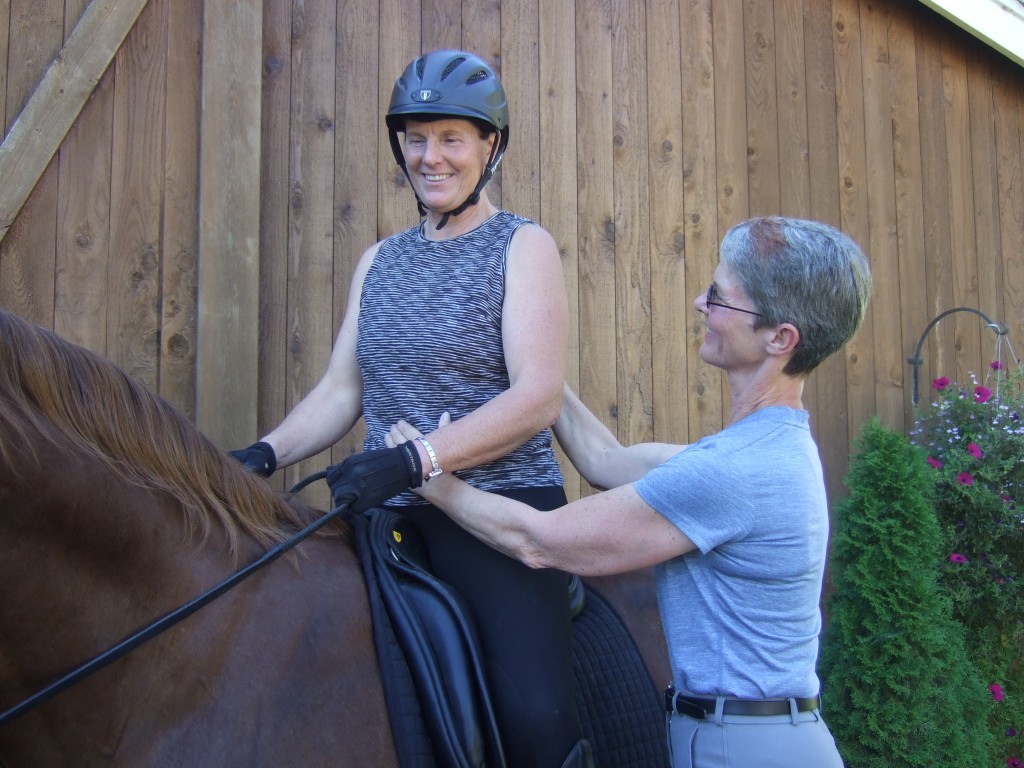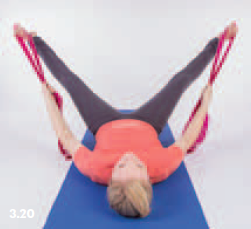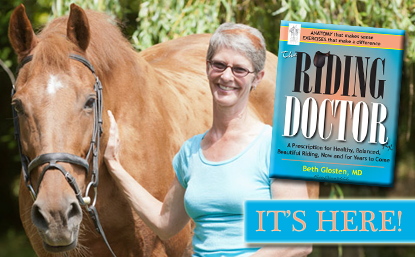
After leaving horses behind for many years to pursue her medical career, Dr. Beth Glosten decided it was time to ride again—only to discover that, as a middle-aged woman, she struggled with tension, awkwardness, and an aching back. Dr. Glosten’s own frustration with riding prompted her to apply her clinical research skills to figure out what it would take to not only create the harmonious picture of horse and rider moving together, but also feel good while doing it. Now, she’s sharing what she learned in THE RIDING DOCTOR, her new book from Trafalgar Square Books.
“By helping you understand how your body interfaces with your horse,” says Dr. Glosten, “I hope to help you meet your riding goals and, at the same time, ride in good health and prevent injury.”
In THE RIDING DOCTOR, readers are introduced to a sensible system of organizing the human body in the saddle, and throughout, “Rider’s Challenge” case studies provide a glimpse of the kinds of problems commonly faced and how to best solve them. Then, Dr. Glosten—who is also a certified Pilates instructor and founder of the RiderPilates LLC fitness program—provides over 50 step-by-step exercises geared toward further developing the riding skills we need to be balanced, effective, healthy riders, now and for years to come.
Here Dr. Glosten shares one rider’s story that explains why sometimes it feels so hard to keep your horse going.
The Rider’s Challenge: Gripping Adductors
Before working with a new rider, I ask her to provide some information about her riding experience, goals, and how I might help her. On her form, Elise states, “I don’t understand why I get so tired after only riding about 30 minutes. I do not think I’m that out of shape!”
I meet Elise on her six-year-old bay Trakehner mare, Peony, and watch her do some warm-up rounds at posting trot and canter. She has a reasonably correct posture and rides with a very positive “come with me” attitude. However, while the mare will initially pick up the canter fairly readily, before long Peony loses impulsion and breaks out of canter.
“It is so much work to keep her going!” Elise exclaims as she comes back to a walk.
I have Elise do some trot work first to sort out the challenge she has keeping Peony moving in canter. At posting trot, Elise maintains good balance and alignment and stays with Peony. At sitting trot, however, it is a challenge for Elise to keep Peony in a rhythmic and ground-covering trot. I see that Elise’s leg gets quite still—too still—and that her back loses its stable position. Her leg position gets so locked that her feet bounce up and down in the stirrup, rather than rest on the stirrup with movement through the ankle joints.
Elise grips hard to keep from bouncing at sitting trot. By doing so, she inhibits Peony’s movement, interfering with her staying in a good trot. I’m suspicious that this is also what is going on in the canter. I explain to Elise that her legs should be against the horse, but not gripping. When the legs grip, it is like riding with the brakes on. Peony responds with a loss of steadiness in the trot and a tendency to break out of the canter.
Remedy
At the halt, I have Elise actively stabilize her spine with her deep abdominal and back muscles, then carefully lift her legs slightly away from the saddle, out to the side. She immediately feels how much heavier she sits in the saddle, in a good way. I have her repeat the exercise at walk to help her learn the sensation of a more supple, less-gripping leg, and a heavier and more anchored position of her pelvis. I emphasize that it is easy to strain her back with this exercise of lifting the legs off the saddle; it must be done carefully with suitable spine support, aiming for a small range of upper-thigh motion, as if she were trying to slide a piece of paper between her leg and the horse.
Back at sitting trot, I again coach Elise to activate her core muscles and then try a few steps of sitting trot, keeping her legs far enough “away” from the saddle to prevent gripping. She does this for a few steps, and begins to feel when the gripping creeps in.
We do the same exercise at canter to try and get her legs to let go and allow Peony to canter freely. To prevent her legs from clinging to Peony’s side, I coach her to give a fairly loose leg aid, being conscious of its beginning and end: apply the aid and then let go. I also tell Elise to, at times, give a light tap with the whip, rather than use a leg aid, to encourage Peony to stay in canter. In this way, Elise feels her legs stay released and free.
Our lesson lasts about 45 minutes, with a lot of transitions and attempts to keep Elise’s leg muscles supple and not gripping at all gaits. At the end Elise remarks, “I don’t remember the last time I rode for 45 minutes straight through without a break.”

Adductor Stretch
Here’s an easy stretch to combat tightness in the adductor muscles of the hip joint.
1. Lie on your back on a mat.
2. Wrap a towel or elastic stretch band around the bottom of each foot.
3. Hold tightly onto the towels or bands while reaching your legs together up toward the ceiling, as straight as possible, and then carefully supporting them in a stretch out to the side. Be sure to avoid changing your pelvic position during this stretch.
4. Hold for 20 to 30 seconds.
THE RIDING DOCTOR is available now from the TSB online bookstore where shipping in the US is FREE.
CLICK HERE to download a FREE CHAPTER or to order.

